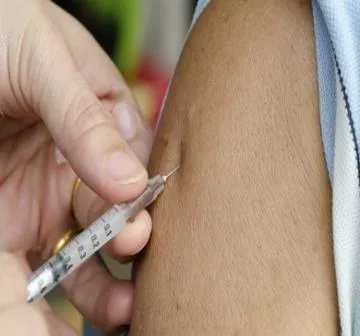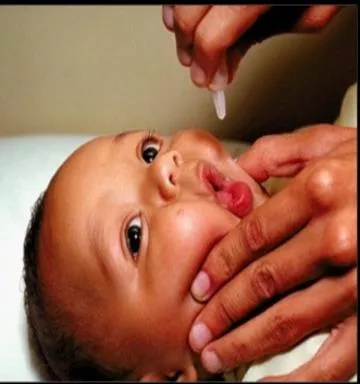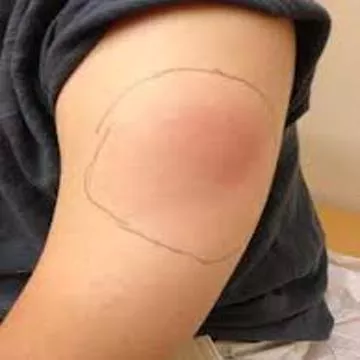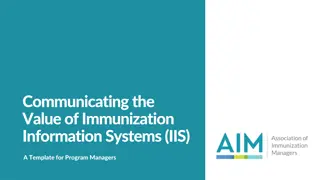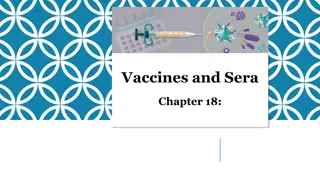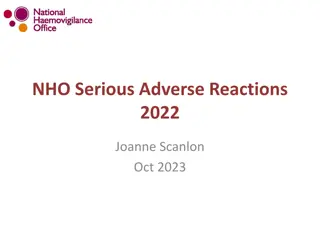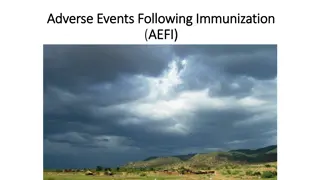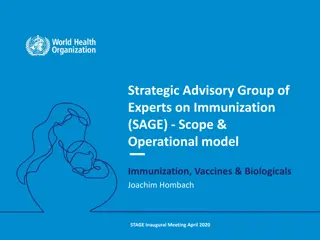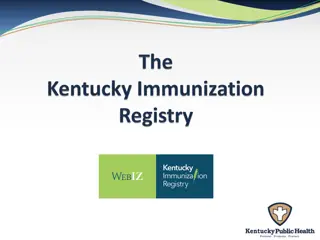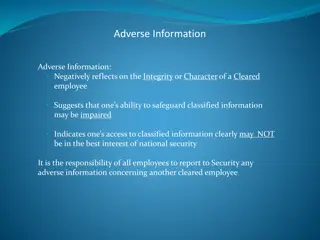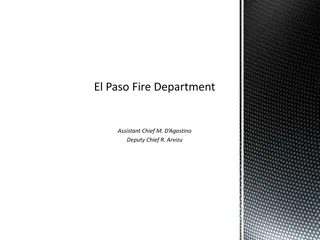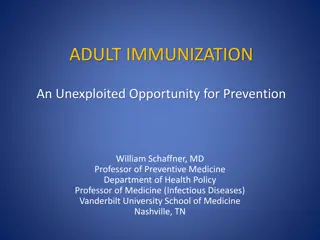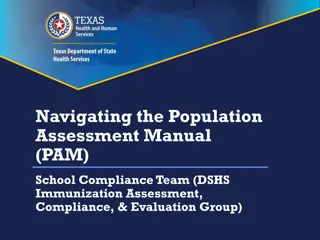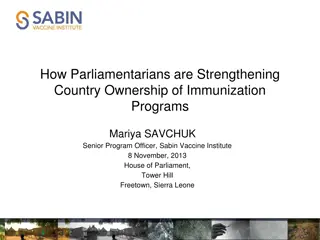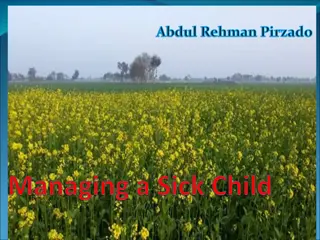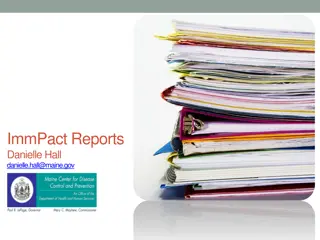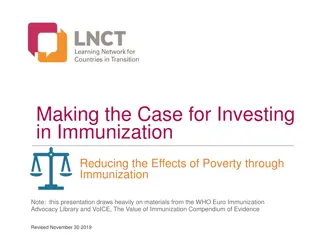Adverse Events Following Immunization
Adverse Events Following Immunization (AEFI) refer to untoward medical occurrences post-immunization. It is crucial to anticipate, prepare for emergencies, and identify causes. Causes of AEFI include vaccine product-related reactions, quality defects, immunization errors, anxiety-related reactions, and coincidental events. Classification of AEFI helps in understanding different types of reactions and their examples.
Download Presentation

Please find below an Image/Link to download the presentation.
The content on the website is provided AS IS for your information and personal use only. It may not be sold, licensed, or shared on other websites without obtaining consent from the author.If you encounter any issues during the download, it is possible that the publisher has removed the file from their server.
You are allowed to download the files provided on this website for personal or commercial use, subject to the condition that they are used lawfully. All files are the property of their respective owners.
The content on the website is provided AS IS for your information and personal use only. It may not be sold, licensed, or shared on other websites without obtaining consent from the author.
E N D
Presentation Transcript
ADVERSE EVENTS FOLLOWING IMMUNIZATION (AEFI) By DR. N. P. RUBESH SHARMA 2/18/2025 1
DEFINITION AEFI is any untoward medical occurrence which follows immunization. The adverse event may be symptom or disease. any unfavorable or unintended sign, abnormal laboratory finding. 2/18/2025 2
Why do we want to Know? To anticipate the occurrence of any adverse event following immunization. To prepare for emergencies due to AEFI during mass immunization campaigns. To identify the cause of AEFI if reported. Note Vaccines used in national immunization programmes are extremely safe and effective. However, no immune response is entirely free from the risk of adverse reactions or remote sequelae.
CAUSES OF AEFI Revised In 2012 by The Council for International Organizations of Medical Sciences (CIOMS} and WHO. Cause Specific categorization of AEFI
Cause-specific categorization of AEFIs (CIOMS/WHO 2012) Vaccine product-related reaction Vaccine quality defect-related reaction Immunization error-related reaction (formerly "programme error") Immunization anxiety-related reaction Coincidental event
CAUSE SPECIFIC TYPE OF AEFI DEFINITION EXAMPLES 1)Vaccine product- related reaction An AEFI that is caused or precipitated by a vaccine due to one or more of the inherent properties of the vaccine product. Extensive limb swelling following DTP vaccination 2) Vaccine quality defect-related reaction An AEFI that is caused or precipitated by a vaccine that is due to one or more quality defects of the vaccine product including its administration device as provided by the manufacturer. Failure by the manufacturer to completely inactivate a lot of inactivated polio vaccine leads to cases of paralytic polio. 3) Immunization error- related reaction formerly programme error ) An AEFI that is caused by Inappropriate vaccine handling, prescribing or administration. Transmission of infection by contaminated multidose vial 4) Immunization anxiety-related reaction An AEFI arising from anxiety about the immunization. Vasovagal syncope in an adolescent following vaccination 5) Coincidental event An AEFI that is caused by something other than the vaccine product, immunization error or immunization anxiety A fever occurs at the time of the vaccination (temporal association) but is in fact caused by malaria.
Cause specific classification of Vaccine Reactions Vaccine product related reaction Vaccine quality related reaction Individual s response to inherent properties of vaccine although it has been prepared, handled and administered correctly Immune mediated reaction or activation of vaccine associated microbial agents( live attenuated virus) It is defect in the vaccine that has occurred during the manufacturing process Insufficient inactivation of wild type virus or introduction of contaminant in vaccine during manufacturing process But this is taken care by the Good Manufacturing Practices and strengthening regulatory boards 2/18/2025 7
Table 2: Categorization of reported adverse events by frequency of occurrence Frequency Category Frequency Rate Frequency % Very common > 1/10 > 10% Common > 1/100 and < 1/10 > 1% and <10% Uncommon > 1/1000 and <1/100 > 0.1% and <1% Rare > 1/10,000 and <1/1000 > 0.01% and < 0.1% Very rare < 1/10,000 > 0.01% Common MINOR reactions: Result as a part of immune response Or due to vaccine components like adjuvant, stabilizer or preservatives 2/18/2025 8
Table 3: Frequency and nature of minor vaccine reactions VACCINE LOCAL REACTIONS SYSTEMIC REACTIONS Pain, Swelling, Redness Fever >38 deg C Malaise, irritability and systemic symptoms BCG 90-95% Hepatitis B Adults- 15%, Children- 5% 1-6% HiB 5-15% 2-10% Measles/ MR/ MMR ~10% 5-15% 5% rash OPV None <1% <1% Pertusis(DTwP) Upto 50% Upto 50% Upto 55% Pneumococcal ~20% ~20% ~20% Tetanus/ DT/ aTd ~10% ~10% ~25% However, if observed rates are more than expected for a vaccine, then investigation is needed to exclude the possibility of adverse reaction for the given vaccine. 2/18/2025 9
SERIOUS AND SEVERE REACTIONS SEVERE REACTIONS --Can be disabling and, rarely, life threatening -- do not lead to long-term problems --Must be reported SERIOUS REACTIONS Results in death. Requires inpatient hospitalization. Results in persistent or significant disability. AEFI cluster Examples- high fever( >102 degree F), hypotonic hypo responsive episodes, prolonged crying etc Requires intervention to prevent permanent damage Examples Anaphylaxis that are potentially fatal 2/18/2025 10
Table 4: Frequency and nature of severe/ serious vaccine reactions VACCINE REACTION ONSET INTERVAL FREQUENCY PER DOSES GIVEN BCG Fatal dissemination of BCG 1-12 months 0.19-1.56/ 1 000 000 OPV Vaccine Associated Paralytic Polio 4-30 days 2-4/ 1 000 000 DTwP Prolonged crying and seizures 0-24 hours <1/100 HHE 0-24 hours <1/100-2/1000 Measles Febrile seizures 6-12 days 1/3000 Thrombocytopenia 15-35 days 1/30 000 Anaphylaxis 1 hour 1/100 000 Rotavirus Intussusception 3-14 days 1-2/100 000 2/18/2025 11
2/18/2025 12
IMMUNIZATION ERROR-RELATED REACTION IMMUNIZATION ERROR RELATED REACTION Exposure to excess heat/cold as a result of inappropriate transport, storage/ handling of vaccine and its diluents Systemic or local reactions due to changes in the physical nature of the vaccine ERROR IN VACCINE HANDLING Formerly called programme error Refers to errors related to all processes that occur after a vaccine product has left the manufacturing/packaging site- handling, prescribing and administration of the vaccine ERROR IN VACCINE PRESCRIBING O NON ADHERENCE TO RECOMMENDATIONS FOR USE Failure to adhere to vaccine indications/ prescription(dose/schedule) Use of a product after its expiry date Failure to protect as result of loss of potency or non-viability of attenuated product Failure to adhere to contraindication Anaphylaxis, disseminated infection due to attenuated vaccine, VAPP Systemic /local reactions, neurologic, muscular, vascular/ bony injuries due to incorrect injection site/ technique Use of an incorrect diluents/ injection of a product other than intended vaccine Failure to immunize, reaction due to inherent properties of whatever administered instead of vaccine Infection at/ beyond the site of injection ERROR IN ADMINISTRATION Incorrect sterile technique / inappropriate procedure with multi dose vial 2/18/2025 13
Clusters of events is two or more cases of the same adverse event related in time, place or vaccine administered. Clusters can be usually associated within: a vial/vials of vaccine that has/have been inappropriately a particular provider or health facility Stored Contaminated (e.g. freezing vaccine during transport). Inappropriately Prepared 2/18/2025 14
PREVENTION OF IMMUNIZATION ERROR Reconstituted vaccines should not be used >4 hrs for BCG and Measles; >2 hrs for JE. Remaining ones to be discarded at end of session The T series vaccines- Open Vial Policy to be followed by writing date and time the vaccine was opened and this can be used upto 4 weeks. No other drugs to be stored in place of vaccines storage in refrigerator Immunization workers must be adequately trained and supervised for proper method of administration of vaccines 2/18/2025 15
IMMUNIZATION ANXIETY RELATED REACTIONS Vomiting, convulsions, screaming Fainting Common in older children and adults Hyperventilation can cause light- headedness, dizziness, tingling around mouth and hands. Breath holding PREVENTION: Short waiting time Comfortable room Privacy Clear explanations about the immunization and Calm, confident administration 2/18/2025 16
COINCIDENTAL EVENTS Coincidental events are inevitable during a mass campaign. There exists temporal association Vaccinations are normally scheduled in infancy and early childhood, when illnesses are common and congenital or early neurological conditions become apparent. 2/18/2025 17
PREVENTION OF COINCIDENTAL EVENTS Expected number of coincidental events after immunization can be estimated by: Applying the normal incidence of disease and death in these age groups Calculation of the expected background rate of that event may be helpful in the investigation of an AEFI Understanding background mortality in the context of deaths that coincidentally follow vaccination Immediate investigation. WHY?? To respond to a community's concerns about vaccine safety Maintain public confidence in immunization The coverage and timing of immunizations 2/18/2025 18
RECORDING AND REPORTING OF AEFI Which to be reported?? Serious AEFI( death, cluster, disability, hospitalization) Minor and severe reactions to be documented Events associated with newly introduced vaccine Immunization error related reaction Significant events of unexplained cause occurring within 30 days after vaccination Events causing parental/ community concern 2/18/2025 19
CHANNELS OF REPORTING a) Monthly reporting This includes reporting of serious and minor reactions from level of occurrence of AEFI to National level. Done using report formats for NHM, HMIS National State HQ Covers 3 main fields- Death, Abscess, Others( all serious and severe AEFI) Urban centres District HQ Nil report if no AEFI case detected in that area during that month PHC/ Block Sub centre 2/18/2025 20
b) Immediate serious and severe AEFI reporting Serious AEFI are first brought to notice of the health system Supervising immunization staff Health care provider who treating the patient Pharmacist Health care worker who administered vaccine Local media Government PHC/CHC or DIO ADR Patient directly monitoring centres 2/18/2025 21
Immediately after notifying/ reporting serious/severe AEFI, a two step process is initiated STEP 1: Reporting serious/severe AEFI (Case Reporting Format{CRF} used) to appropriate authority STEP 2: District level investigation of reported AEFI However case management remains the priority over reporting but health authorities need to respond immediately to reported cases. 2/18/2025 22
2) Case Investigating Forms- Preliminary(PCIF) and Final(FCIF) investigating forms capture in depth information about reported AEFI and circumstances of occurrence. It guides the investigating team to collect information required for causality assessment of AEFI . 2/18/2025 23
Figure: Preliminary and Final Case Investigating forms routing and timeline 2/18/2025 24
AEFI INVESTIGATION The ultimate goal of case investigation is to prepare a clinical diagnosis based on the chronology of medical events, detailed history and other evidence such as laboratory investigations. Once probable diagnosis is available, it helps in finding the cause and undertaking appropriate response. Immune related errors and vaccine product reactions are preventable and hence should be identified. Co-incidental events should be recognized . Finally investigation is necessary to keep up the confidence of public in immunization programme 2/18/2025 25
STEPS IN INVESTIGATING AEFI 1. Immediate AEFI case notification by the health worker in person or phone 2. Case visit for confirmation and reporting by the medical officer 3. Decision on investigation by the DIO and District AEFI committee 4. Preliminary AEFI case investigation, laboratory investigation, report submission and action at the local level 5. Review and Final AEFI case investigation and report submission by district to state. 6. Causality assessment by the State AEFI committee and conclusion of the investigation 7. Review and finalisation of submitted Causality assessment by National AEFI Committee 8. Coordinating and taking action at state and national level 2/18/2025 26
INVESTIGATING AEFI DEATH AEFI reported death should be immediately investigated without delay and should be notified to all administrative levels. The investigating team comprises of clinical, laboratory and forensic experts Autopsy within 72 hours If autopsy not possible, obtain biological specimens from the dead for lab tests Essential to carry out a focused verbal autopsy DEATH Visit to home Visit to treating health care provider Interaction with vaccinator Visit to community for sociocultual setting Other source of information Verbal autopsy Medical consultation Hospital records Lab investigations 2/18/2025 27
INVESTIGATING AEFI CLUSTERS 2/18/2025 28
Cluster AEFI CASE STUDY: In 2008, in state C, 3 infants died after administration of measles vaccine. Symptoms such as fever, rash, vomiting with diarrhea( toxic shock syndrome as described by health worker) developed within an hour. Reconstituted vaccines were routinely kept until it was used and as AD syringes were unavailable, the vaccinator used glass syringes which weren't sterilized but washed with ordinary water and wiped with cotton wool. No testing could be done. CAUSE: Non-sterile injection (contaminated reconstituted vaccine) 2/18/2025 29
LABORATORY TESTING Lab testing is not mandatory following AEFI if cause is evident However if required biological samples, vaccines, diluents and logistics are performed. The samples have to be sent with documents like LRF, CRF, CIF and others with clear labeling and maintenance of reverse cold chain Collection, packaging, cold chain maintenance and transportation of samples are the responsibilities of DIO and drug inspector. 2/18/2025 30
TABLE : Biological samples collection for testing following AEFI EVENT SPECIMEN FROM THE PATIENT Severe local reaction -Abscess -Lymphadenitis Swab, blood CNS adverse events -CNS symptoms no paralysis -CNS symptoms with paralysis CSF, blood Stool( suspecting AFP following OPV) Others -Anaphylaxis -Toxic shock syndrome -Death Blood, blood culture, Postmortem tissue, urine Autopsy conducted in suspected death following AEFI be conducted within 72 hours to avoid tissue damage, postmortem artifact and lysis of adrenal glands that alter diagnosis 2/18/2025 31
Biological specimens- Accredited and approved lab by district/ state AEFI committee For samples following JE vaccination: NIV Pune or Gorakhpur. Autopsy specimen- approved state forensic lab As per Central Drug Standard Control Organization(CDSCO), - Vaccines and diluents for sterility and chemical composition: CDL Kasauli - Syringes and needles for sterility: CDL Kolkata 2/18/2025 32
Vaccine collection for lab Prepare 4 sealed sets with equal quantity in each and send 1 set to CDL Kasauli 1 set at site of collection Retain 2 sets with drug inspector Separate plastic zipper bag is used for different vaccines and diluents Name, age, date of collection, AEFI/EPID number, point of collection of vaccine is mentioned Packed zipper bag is kept in a bigger zipper bag This is placed in cardboard box tied with strings from all sides and official seal is affixed . Transported in cold chain 2/18/2025 33
CAUSALITY ASSESSMENT Causality assessment is the systematic evaluation of the information obtained about an AEFI to determine the likelihood of the event having been caused by the vaccine received. Done by State AEFI Committee. Final report should include- Diagnosis, Type of adverse event and key remarks of district and state AEFI committees. 2/18/2025 34
STEP 1: ELIGIBILITY 2/18/2025 35
CASE DEFINITIONS AND TREATMENT ADVERSE EVENT CASE DEFINITION TREATMENT VACCINES Disseminated BCG infections Widespread infection occurring within 1 to 12 months after BCG vaccination and confirmed by isolation of Mycobacterium bovis BCG strain. Usually in immunocompromised individuals. Should be treated with anti- tuberculous regimens including isoniazid and rifampicin BCG Encephalopathy Acute onset of major illness characterized by any two of the following three conditions: seizures severe alteration in level of consciousness lasting for one day or more distinct change in behaviour lasting one day or more. Needs to occur within 48 hours of DTP vaccine or from 7 to 12 days after measles or MMR vaccine, to be related to immunization. No specific treatment available; supportive care. Measles, Pertusis Fever The fever can be classified (based on rectal temperature) as mild (38 to 38.9oC), high (39 to 40.40C) and extreme (40.5oC or higher). Fever on its own does not need to be reported. Symptomatic; paracetamol. All 2/18/2025 36
Hypotonic hyporesponsive episode (HHE or shock-collapse) Event of sudden onset occurring within 48 (usually less than 12) hours of vaccination and lasting from one minute to several hours, in children younger than 10 years of age. All of the following must be present : limpness (hypotonic) reduced responsiveness (hyporesponsive) pallor or cyanosis - or failure to observed/recall self-limiting and does not require specific treatment. It is not a contraindication to further doses of the vaccine. Mainly DTB rarely others Injection site abscess Fluctuant or draining fluid-filled lesion at the site of injection. Bacterial if evidence of infection (e.g. purulent, inflammatory signs, fever, culture), sterile abscess if not Incise and drain; antibiotics if bacterial. All Lymphadenitis includes suppurative lymphadenitis) Either at least one lymph nodes enlarged to > 1.5 cm in size (one adult finger width), or a draining sinus over a lymph node. Almost exclusively caused by BCG and then occurring within 2 to 6 months after receipt of BCG vaccine, on the same side as inoculation (mostly axilliary). Heals spontaneously (over months) and best not to treat unless lesion is sticking to skin. If so,or already draining, surgical drainage and local instillation of anti-tuberculous drug. Systemic treatment with anti-tuberculous drugs is ineffective. BCG 2/18/2025 37
Osteitis/ Osteomyelitis Inflammation of the bone with isolation of Mvcobacterium bovis BCG strain. Should be treated with anti-tuberculous regimens including isoniazid and rifampicin. BCG Persistent inconsolable screaming Inconsolable continuous crying lasting 3 hours or longer accompanied by high- pitched screaming Settles within a day or so; analgesics may help. DTP Pertussis Seizures Occurrence of generalized convulsions that are not accompanied by focal neurological signs or symptoms. Febrile seizures: if temperature elevated >38oC (rectal) Afebrile seizures : if temperature normal Self-limiting supportive care; paracetamol and cooling if febrile; rarely anticonvulsants. All, especially Pertussis, Measles 2/18/2025 38
Severe local reaction Redness and/or swelling centered at the site of injection and one or more of the following: o swelling beyond the nearest joint o pain, redness, and swelling of more than 3 days duration o requires hospitalization. Local reactions of lesser intensity occur commonly and are trivial and do not need to be reported. Settless spontaneously within a few days to a week. Symptomatic treatment with analgesics. Antibiotics are inappropriate. All Toxic shock syndrome (TSS) Abrupt onset of fever, vomiting and watery diarrhoea within a few hours of immunization. Often leading to death within 24 to 48 hours. Needs to be reported as possible indicator of programme error. Critical to recognize and treat early. Urgent transfer to hospital for parenteral antibiotics and fluids All Acute Flaccid Paralysis Acute onset of flaccid paralysis within 4-30 days of receipt of OPV or within 75 days after contact with vaccine recipient neurological deficits remaining 60 days after onset Or death Supportive treatment OPV 2/18/2025 39
ANAPHYLAXIS Severe and immediate allergic reaction (within 1 hour) leading to circulatory failure with or without bronchospasm and/or laryngospasm/laryngeal edema . Dermatological or mucosal Respiratory Cardiovascular Persistent dry cough Hoarse voice Difficulty breathing without wheeze or stridor Sensation of throat closure Sneezing and rhinorrhea Hypotension Uncompensated shock (tachycardia, CFT>3secs, reduced central pulse volume, decreased level of consciousness or unconsciousness Gen. urticaria or erythema Localized or generalized angioedema Generalized pruritus with skin rash Gastrointestinal Diarrhea Abdominal pain Nausea Vomiting 2/18/2025 40
TREATMENT Follow A, B, C Oxygen Give INTRAMUSCULAR INJECTION (IMI) OF ADRENALINE 1:1000 IM into outer mid thigh 0.01mg per kg up to 0.5mg per dose Repeat every 5 minutes as needed, max 3 doses IV fluids(NS/ RL) Inj. Hydrocortisone Antihistamine Salbutamol nebulisation 2/18/2025 41
CONCLUSION Vaccines are an essential component of health service delivery.The goal of immunization is to protect the individual and the public from Vaccine Preventable Diseases. Although modern vaccines are safe, no vaccine is entirely without risk; and adverse reactions will occasionally occur following immunization. The vigilance of healthcare providers on vaccine safety has increased due to strengthening of AEFI surveillance. As a result more concerns on the quality and safety of vaccines are highlighted. 2/18/2025 42
Due to increased immunization coverage the incidence of VPDs are decreasing and more attention is being given towards AEFI. Therefore it is essential to report, investigate and assess each AEFI to determine whether a vaccine is causally linked to an AEFI or it is a mere coincidence. 2/18/2025 43
REFERENCES K Park. Text book of preventive and social medicine. 23rd ed. Jabalpur: Banarsidas bhanot; 2/18/2025 44


